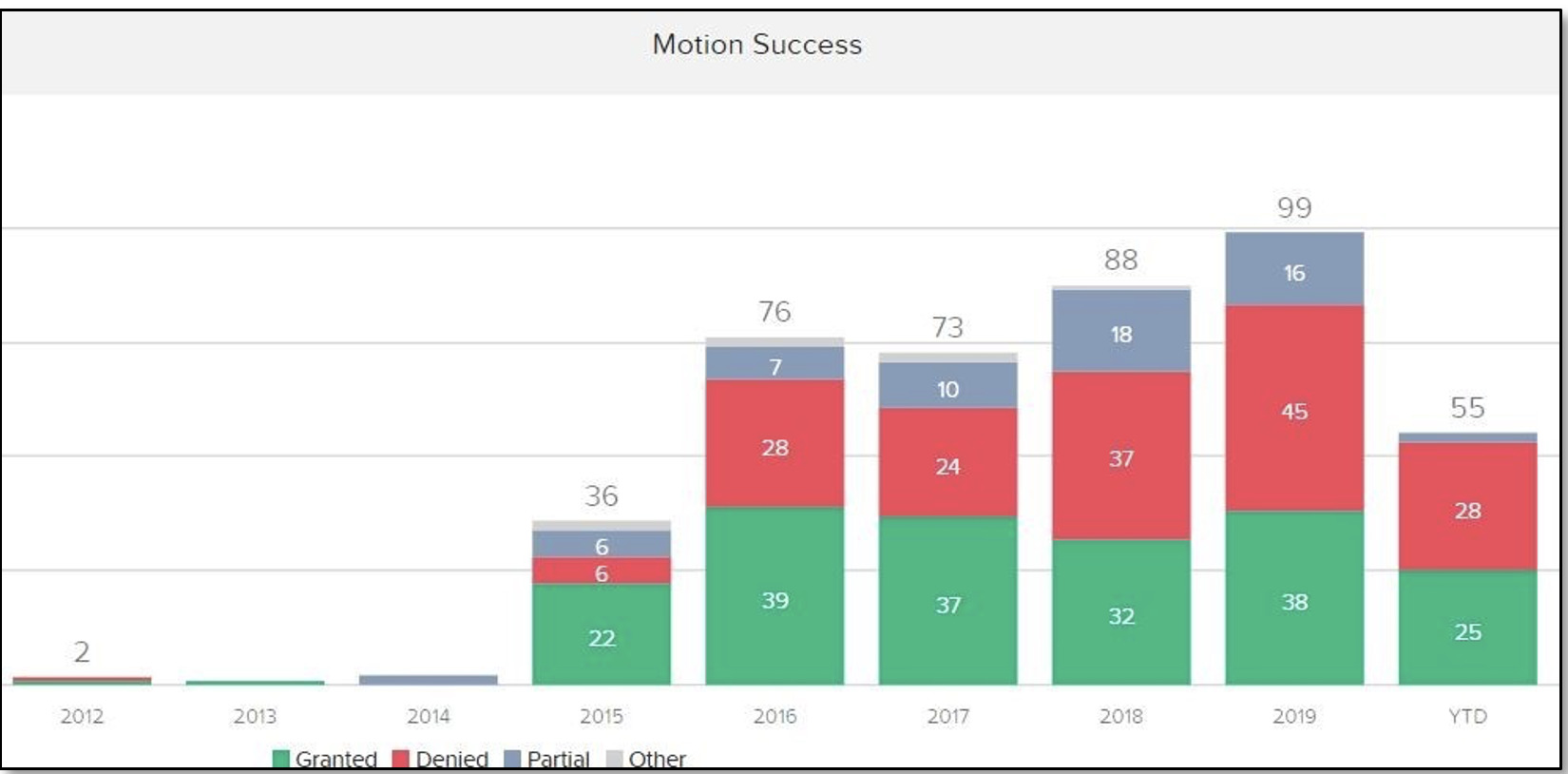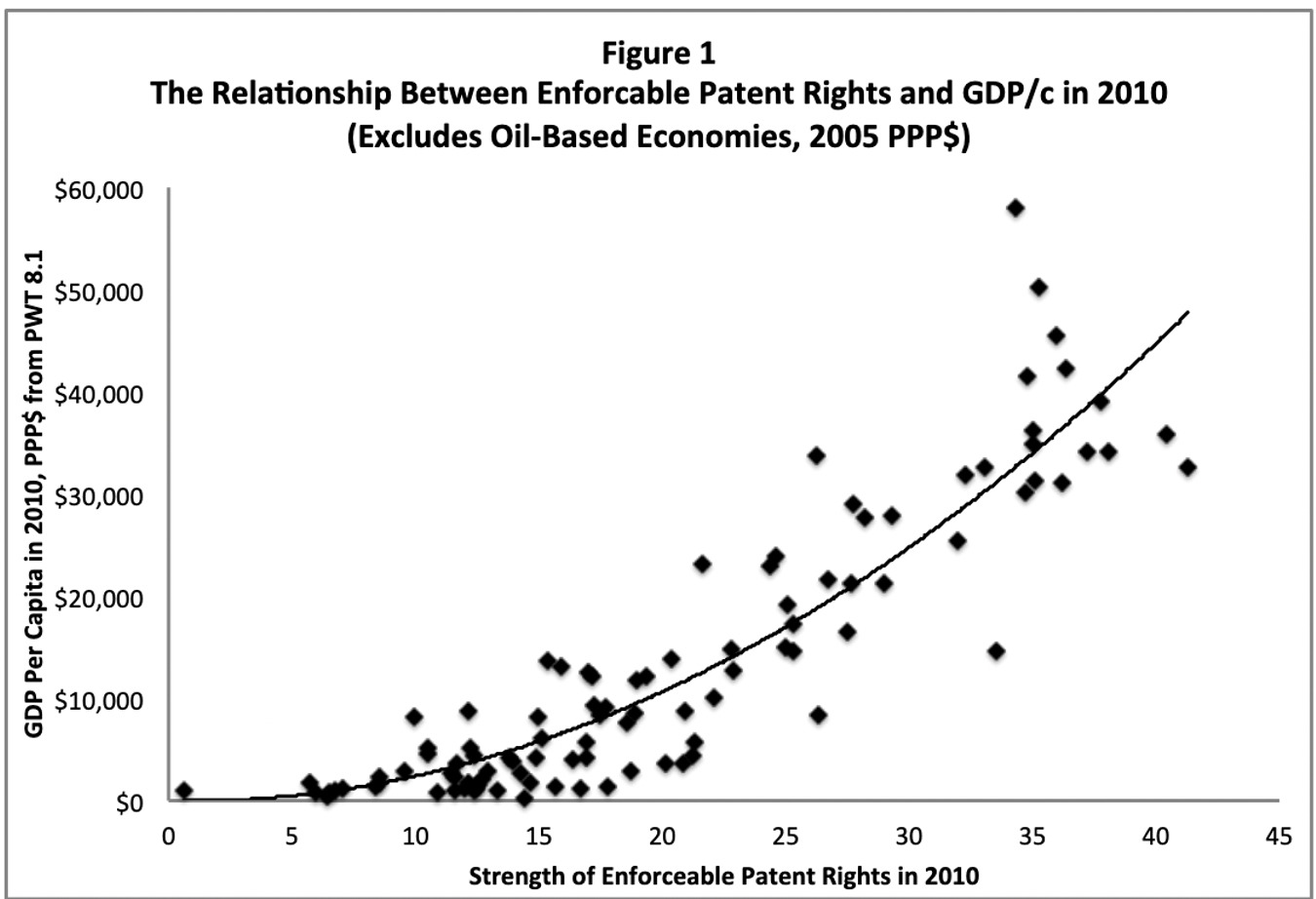“As the final conclusion for this article series, the data, studies and analysis of an overwhelming body of scholars, government officials and innovators require the conclusion that reform of Section 101 is urgently needed to ensure U.S. competitiveness and enhance national security moving forward.”
 The current unreliability of patent-eligibility law, documented thus far here, here and here, has also created undue burdens on litigants and the courts. In this final installment, we detail how the current unreliability burdens litigants and the courts and how it is a fundamental threat to U.S. competitiveness and national security.
The current unreliability of patent-eligibility law, documented thus far here, here and here, has also created undue burdens on litigants and the courts. In this final installment, we detail how the current unreliability burdens litigants and the courts and how it is a fundamental threat to U.S. competitiveness and national security.
Patent infringers now routinely raise Section 101 as a defense, often merely as a strategy to complicate and prolong the litigation, rather than as a good-faith defense with a likelihood of success. For example, one analysis found that, from 2012 to 2014 (when Alice was decided), Section 101 was raised in just two Rule 12(b)(6) motions across the country each year. In the year after Alice, that number rose to 36 motions, and by 2019, accused infringers were filing over 100 such motions each year.
Moreover, while the success rate of these motions skyrocketed in the first years after Alice—illustrating Alice’s impact on granted patent rights—by 2019, the percentage of such motions granted was only 38%. Thus, almost two-thirds of all such 12(b)(6) motions accomplished little more than imposing time and expense on patent owners trying to vindicate their patent rights.

Another analysis similarly found that, in the 30 months prior to Alice, district courts had entertained 20 Section 101 motions to dismiss. Between June 19, 2014, and July 31, 2018, that number totaled 365 decisions on these types of motions—representing a 1,725% increase.
As another indication of the burdens that post-Mayo/Alice Section 101 is imposing on litigants and courts, the District of Delaware—one of the busiest patent dockets in the country—has established dedicated “Section 101 days” to deal with a docket that has “become flooded with legal briefs arguing that a patent covers ineligible material.”
Fixing America’s Eligibility Problem Will Attract and Encourage More Domestic Innovation
Innovators and creators are, and have always been, incentivized by intellectual property rights, including the grant of exclusive patent rights. The Founders knew this, and we know this today. Patent rights encourage inventors to invent, and investors to invest. Numerous studies confirm the fundamental value of IP rights and their positive role in incentivizing innovation. We discuss two, though many others make very similar points.
For instance, Stephen Haber’s article, Patents and the Wealth of Nations, from 2016, details the evidence-based value of property rights, as well as intellectual property rights. His article starts: “There is abundant evidence from economics and history that the world’s wealthy countries grew rich because they had well-developed systems of private property.”
More directly, Haber expands on this point:
“These ideas are not in dispute; they have been tested again and again, across multiple subfields of economics—but that presents us with a puzzle. If both reason and evidence point to the crucial role played by property rights in the wealth of nations, then how can some scholars hold that strong rights to intellectual property (‘IP’) are hindering innovation and holding back economic growth? Should not the same logic hold for IP as for any other kind of property?”
Haber also includes data to support the proposition that reliable and enforceable IP rights are economically beneficial to countries that provide them, not just to the innovators that they protect. For instance, data presented show “that roughly three-quarters of the cross-sectional variance in per capita GDP around the world is explained by the strength of patent rights,” as shown in the following graph.

Other researchers have further confirmed the economic value of reliable and enforceable patent rights. For instance, a 2021 research paper by Harvard University Fellow Jacob Mascona established increased productivity in U.S. agriculture based on strengthening patent rights. In that research, Dr. Mascona concludes that “[p]atent rights were thus successful at providing ex ante incentives for technology development and growth in physical productivity.” More fundamentally, Dr. Mascona explains that his analysis “stands in contrast to claims that patent rights are inconsequential by documenting that the extension of patent protection to plant biotechnology led to a dramatic increase in technology development and shaped patterns of productivity and profits across the US.”
Some who oppose reforms to eligibility law make the incredible claim that strengthening patent rights would reduce innovation by domestic U.S. entities. These claims generally rely on a 20-year-old report by Josh Lerner, published in 2002, which is at odds with the bulk of the research (including the examples above), history, experience, and common sense.
The United States Needs Increased Innovation and Reliable Protection to Remain Competitive with China
Patent-eligibility reform is also needed to stay competitive with China and to address its rise in technological expertise in key areas, such as artificial intelligence, quantum computing, autonomous vehicles, biotechnology and related areas. Without reasonable and reliable guidance on patent eligibility, the U.S. will be unable to keep apace of China’s progress in these key tech areas.
In the United States, rulings continue to weaken the IP regimes that should incentivize innovation, but China’s leaders continue to upgrade their own legal and economic regimes. China’s goal is to surpass the United States and all other nations in 10 advanced technologies, from artificial intelligence to robotics and aerospace equipment. China’s “Made in China 2025” plan seeks to position China by 2025 as the global industrial and technological superpower. According to its very public “New Generation Artificial Intelligence Development” plan, China commits to become, by 2030, “the world’s premier artificial intelligence innovation center,” which in turn will “foster a new national leadership and establish the key fundamentals for an economic great power.”
Along similar lines, and as noted above, the National Security Commission on Artificial Intelligence’s March 2021 report emphasized the urgent need to fix deficiencies in our protection systems if the United States is to continue to lead the world in advanced technologies and assure its national security. The NSCAI was chaired by Eric Schmidt, former CEO of Google. The NSCAI concluded that the United States “lacks the comprehensive IP policies it needs for the AI era and is hindered by legal uncertainties in current U.S. patent eligibility and patentability doctrine.”
A central reason for the “policy void” is the “legal uncertainties created by current U.S. patent eligibility and patentability doctrine,” a result of which is that the “U.S. could lose its prime position in IP global leadership.” The NSCAI report further noted that “U.S. courts have severely restricted what types of computer-implemented and biotech-related inventions can be protected under U.S. patent law” and that “critical AI and biotech-related inventions have been denied patent protection since 2010.” Congress needs to implement, as the NSCAI explained, “a plan to reform IP policies and regimes in ways that are designed to further national security priorities.”
More recently, Professor Graham Allison at Belfer Center for Science and International Affairs (Harvard Kennedy School) prepared a major study titled “The Great Rivalry: China vs. the U.S. in the 21st Century” (“Allison Report”). The Allison Report was originally prepared as part of a package of transition memos for the Biden administration after the November 2020 election. As the Belfer Center states when it announced the Allison Report, “[t]he big takeaway for the policy community is that the time has come for us to retire the concept of China as a ‘near peer competitor’” and that “[w]e must recognize that China is now a ‘full-spectrum peer competitor.’”
Even just a few points from the Allison Report make it easy to understand the significance of China’s rise and the role intellectual property will play in maintaining the United States’ competitiveness:
- CIA Director William Burns calls tech rivalry the “main arena for competition and rivalry with China”;
- “China has become a serious competitor in the foundational technologies of the 21st century . . . .”
- “In some races, it has already become No. 1. In others, on current trajectories, it will overtake the U.S. within the next decade.”
- “President Xi Jinping has declared, ‘Technological innovation has become the main battleground of the global playing field, and competition for tech dominance will grow unprecedentedly fierce.’”
- Eric Schmidt said, “Unless these trends change, in the 2030s we will be competing with a country that has a bigger economy, more research and development investment, better research, wider deployment of new technologies, and stronger computing infrastructure.”
What this means for investors and innovators in patent-reliant fields is that the strength of our country’s IP laws—including patent eligibility—will be a key factor influencing where they direct their investments, where they choose to base their R&D activities, and where they focus their commercialization activities. See sources here. This is why industries that rely heavily on patents—such as innovative biopharmaceuticals—initially emerged and developed only in countries with strong patent systems. No rational investor would commit billions of dollars to research and develop complex medicines and other innovative technologies without a reasonable assurance of reliable patent protection. Strong IP protection is also why, for the most part, major R&D operations in those industries continue to be concentrated in such markets today.
China is a case in point. With a historically weak IP system for biopharmaceuticals and software, no foreign innovators in these fields placed major R&D operations or invested in significant R&D activity in China. That changed when the government began strengthening its biopharmaceutical and software IP laws over the last decade. Today, as China’s patent laws begin to rival—and, in the case of patent eligibility, surpass—U.S. patent laws, we have seen an explosion of R&D investment and innovation in China, including massive investments by foreign investors and foreign innovative companies. See sources here. In the pharmaceutical field, this expanded investment includes human clinical trials—once a rarity in China and other countries because of weak local IP laws. See sources here.
Now though, there are examples of hundreds of patent applications that were approved as patents in China but rejected as ineligible in the United States—and all due to Section 101. Given past U.S. leadership relative to other world economies in providing patent protection for new innovations, the disparate outcomes in seeking protection of intellectual property represent a disruptive trend for the future of the U.S. innovation economy.
If this trend continues, we will see innovation leadership and investors dramatically shift to other jurisdictions, including China. As noted, China is swiftly becoming the leading country for many technologies, and leadership coincides with China strengthening its patent system. From 2016 to 2020, the market capitalization of Chinese biopharma companies increased exponentially in value, from $1 billion to over $200 billion, and “China saw over $28 billion invested in its life sciences sector in 2020, double the previous year’s amount.” In 2019, the U.S. Food and Drug Administration approved a drug developed in China for the first time ever. All of this has occurred even as China continues to strengthen its patent laws.
Furthermore, China is granting local innovators and inventions an advantage. China continues to award certain IP rights only to medicines whose global launch first occurs in China. It also requires foreign innovators to enter into forced R&D collaborations and IP-sharing arrangements with local entities if they involve local human genetic resources. Similar discrimination happens in other IP-intensive industries in China (as well as other markets around the world) as documented in USTR’s annual Special 301 and NTE Reports.
Professor Falati’s 2020 article further explores these concerns:
“For example, it should be a warning to our law and policy makers that Chinese AI start-ups are now receiving more funding than American AI start-ups. According to a review published in 2018 by MIT Technology Review, of the $15.2 billion invested in AI startups globally in 2017, 48 percent went to China and just 38 percent to America. The U.S. is starting to lose out in capital investments in key industries, such as artificial intelligence which has interconnections to newly emerging medical diagnostic technologies, highlighted by the fact that while the U.S. accounted for 77 percent of such investment before the Alice decision, that investment fell to 50 percent three years after the Alice decision.”
Differences Between Technologies May Explain Some Differential Effects from the Confusion in Patent Eligibility Law
Some who have opposed reforms to patent eligibility law attempt to justify their position by claiming that progress in the high-tech sector has not been shown to have been impeded by the status quo. That contention is belied by the many examples of technology in the tech sector that we included in this paper.
More fundamentally, though, this contention misses a critical point about how patent rights benefit and are used differently by different technology sectors. These differences are explained in detail in research by Professor Barnett and compiled in his recent book Innovators, Firms, and Markets: The Organizational Logic of Intellectual Property (Oxford Univ. Press 2021). In his book, Professor Barnett details how “today substantial categories of patent owners no longer have any reasonable expectation of securing injunctive relief against infringing users, effectively putting in place a compulsory licensing regime in which those patent owners must undertake costly and unpredictable legal actions in multiple venues, often against especially well-resourced defendants . . . that can litigate almost indefinitely.” Professor Barnett’s analysis also recognizes that “some of the world’s largest companies”—as well as the richest—are guilty of the disregard of patent rights. It is a grim conclusion indeed.
Moreover, Professor Barnett explains how different markets and industry sectors use IP rights. The traditional view is that strong patent rights incentivize innovation, and this holds true in vertically disintegrated industries for funding and commercialization, such as the biotech and pharmaceutical sectors. Biotech and pharma innovation requires significant R&D expenditures, and the attendant risks are usually borne by the entities undertaking the research and development activities (whether large or small innovators). The R&D innovators take the risk but can do so only if the patent rights are strong and reliable. For research initially conducted upstream by non-commercial or early-stage companies, patents must also be strong and reliable so that they can be licensed downstream and then commercialized by different entities who have the requisite expertise.
The same does not necessarily hold for integrated tech companies. Large Silicon Valley tech companies can afford to proceed with innovation through an efficient infringement business plan. Professor Barnett explains that “[i]t is therefore unsurprising that today’s largest technology firms (outside of the biopharmaceutical industry), which typically operate under vertically or systems-level integrated structures, have been among the most active advocates for dismantling the strong-patent regime that emerged in the early 1980s.” Rather than license innovation, the large tech companies coopt it and elect to wage expensive patent infringement battles. This path of weakening IP rights, as Professor Barnett notes, can “raise entry barriers to smaller and less integrated entities that rely on IP-mediated transactional structures to extract a return on R&D in the absence of an end-to-end commercialization infrastructure.”
In other words, because of weak IP rights, small innovative tech firms are at a distinct disadvantage compared to the tech giants (like Google, Facebook, Apple, and the like). The larger, integrated firms can infringe and bring a product to market based on a smaller firm’s innovation, but the smaller firm is unlikely to recoup its investment because of weakened IP rights. The end-result may not necessarily be a decline in overall innovation. Instead, the end-result is that smaller innovators are kept out of the market, while the larger, entrenched, integrated tech giants maintain their dominance.
This result is detrimental to the long-term innovation and commercial output of the United States. After all, Google—the market leader in online search—started because of patents issued to its two founders. Had those patents been invalidated under Section 101, perhaps it would have been a different company that coopted their innovation.
The Way Forward
The authors—and the many like-minded innovators, investors, industries, associations, University tech-transfer offices, academics, and other groups, organizations and individuals that share our concerns for the future of American innovation and American leadership—support a sensible legislative reform approach that restores patent-eligibility to the many fields of important innovations that have been negatively impacted, and stand to be negatively impacted, by current eligibility jurisprudence, while at the same time addressing legitimate concerns over the patenting of mere ideas, the mere discovery of what already exists in nature, and social and cultural content that is beyond the scope of the patent system as one aimed at promoting technology-based innovation.
The best way to achieve this at this stage is an approach that 1) maintains the existing statutory categories of eligible subject matter, which have worked well for over two centuries, 2) enumerates a specific and closed list of excluded subject matter based on informed and thoughtful policy determinations by Congress; and 3) abrogates all judicially-created exceptions to eligibility, and all case law interpreting these exceptions, in line with Congress’s authority and mandate to set the nation’s patent laws and policies under the United States Constitution.
As the final conclusion for this article series, the data, studies and analysis of an overwhelming body of scholars, government officials and innovators require the conclusion that reform of Section 101 is urgently needed to ensure U.S. competitiveness and enhance national security moving forward.
Read the whole series:
Presenting the Evidence for Patent Eligibility Reform: Part I – Consensus from Patent Law Experts
Image Source: Deposit Photos
Image ID: 3490146
Author: Feverpitch

![[IPWatchdog Logo]](https://ipwatchdog.com/wp-content/themes/IPWatchdog%20-%202023/assets/images/temp/logo-small@2x.png)




![[Advertisement]](https://ipwatchdog.com/wp-content/uploads/2024/04/Artificial-Intelligence-2024-REPLAY-sidebar-700x500-corrected.jpg)
![[Advertisement]](https://ipwatchdog.com/wp-content/uploads/2024/04/UnitedLex-May-2-2024-sidebar-700x500-1.jpg)
![[Advertisement]](https://ipwatchdog.com/wp-content/uploads/2024/04/Patent-Litigation-Masters-2024-sidebar-700x500-1.jpg)

![[Advertisement]](https://ipwatchdog.com/wp-content/uploads/2021/12/WEBINAR-336-x-280-px.png)
![[Advertisement]](https://ipwatchdog.com/wp-content/uploads/2021/12/2021-Patent-Practice-on-Demand-recorded-Feb-2021-336-x-280.jpg)
![[Advertisement]](https://ipwatchdog.com/wp-content/uploads/2021/12/Ad-4-The-Invent-Patent-System™.png)






Join the Discussion
14 comments so far.
nOObish.me
January 24, 2023 01:43 amAn instance of efficient infringement likely prevented a global catastrophe when in 2005 the internet itself reached a perilous crisis (that very few were ever aware of.)
By 2005 it was widely recognized by the world’s top Internet engineers, researchers, and the US Government that the foundational infrastructure of the Global Internet was rapidly crumbling and would soon exceed its functional capacity with potentially catastrophic consequences.
“The Net’s basic flaws cost firms billions, impede innovation, and threaten national security. It’s time for a clean-slate approach.” – MIT’s David D. Clark – December 2005.
You can read more about that here: https://www.technologyreview.com/2006/02/15/229667/the-internet-is-broken/
At that time, the internet was very inefficient. A huge portion of the internet was unusable for sending information such as emails, websites, pictures, music and video, due to timing conflicts and other structural deficiencies causing crippling transmission delays among the large internet servers spanning the globe. Internet engineers called this the ossification of the Internet.
This crisis arose because the Internet’s original designers failed to anticipate just how much humanity would come to demand from the internet, and come to depend on it. In order for the Internet to survive, the very foundation of the Internet would need to be redesigned and rebuilt.
The “clean slate” solution implemented is one of the most consequential patents in the history of the world. But you’ve likely never heard of this patent or its inventor, and because it was so efficiently infringed, you probably never will.
It is well documented that the core of engineers who rebuilt the internet had read his patent and responded that they had no interest in it, then proceeded immediately and covertly to build it.
As a result, the Internet did not come to a grinding halt. Instead, an explosion of groundbreaking advancements in science and medicine, artificial intelligence and neural networks, security, financial technologies, manufacturing and military capabilities, and much, much more, were all achieved because a new and faster, more capable, more efficient, and more resilient real-time internet infrastructure was quietly deployed.
Years later revealing it to the world as their own invention, these individuals gained false fame and made their personal fortunes, leaving the true inventor out in the cold and in the dark, and without any of the rewards.
Like Nikola Tesla, tragically, “lost to history” is the probable fate of the noteworthy inventor who, relying in good faith on the purported assurances and protections granted him by his US Patent, fulfilled his end of the promised bargain by openly sharing (as a US Patent) and widely distributing his design (directly to the top engineers of the internet, at the very moment they needed it) so that the catastrophe could be averted.
I think he is an unsung hero of our time.
And I think he is just one of many.
And I think word gets around.
Efficient Infringement = Next global catastrophe not averted because the next young genius has not even the illusion of protection from lying, thieving corporate vultures?
nOObish.me
January 23, 2023 02:30 pmThank you, authors, so very much for facilitating this important conversation.
As results when Mother Nature goes on a rampage, smashing her own bodily plates together to the extent that new continents are formed; the cataclysms of structural reformation to the People’s Patent System bought and wrought over the last decade by the leaders of our Big Tech companies have methodically abolished every remaining incentive for our nation’s independent innovators to share their most important inventions for the benefit of the people.
Anon
October 28, 2022 01:15 pmNight Writer,
I do not doubt your perspective, but then — to you — MaxDrei’s shilling (which has been labeled EPO Uber Alles), must be even more insulting, as he pretends that there is NO “US Sovereign aspect” that would (or could) rise to the EPO Way – and thus all things US must be diminished and the EPO version “BE” the only version worth focus.
Night Writer
October 28, 2022 08:30 amanon > “field of technology”
You know I worked and lived in Europe and was an inventor. The “field of technology” is the EPOs way of being the follower to the USA. The “field of technology” only works if you don’t have ground breaking inventions and want to follow along another country like the USA.
Think about it.
Anon
October 28, 2022 08:15 amThe fact that MaxDrei (yet again) shills for “field of technology” is enough for me to vomit just a little in my mouth — and avoid the ‘conversation’ here.
Useful Arts is simply more than merely “technological arts.”
The attempted aversions otherwise amount to no more than an attempted LIE.
Model 101
October 27, 2022 07:24 pmThanks for writing this series of articles. I hope they move congress to eligibility reform fast.
If not….the US patent system is doomed because evidence doesn’t matter any more.
It’s true that a generation of inventors and attorneys will stop the invention process because of the 101 uncertainty.
Sad.
B
October 27, 2022 05:35 pm@ Max Drei
Let me most respectfully declare your first reason as questionable at best and your second reason as absurd. Short cuts on evidence lead to wrong decisions where idiotic and capricious rules based on even more idiotic theories trump reality.
Also, the issue in American Axle was 112a enablement, the issue in Investpic was 112f, and a 103 analysis answers whether a man made thing preempts unduly
Max Drei
October 27, 2022 04:43 pmI write from Europe. It is no surprise to me that so much heat is generated by the eligibility issue. There are two reasons.
First, such a high proportion of innovation is on the border between a field of technology and a field (such as methods of doing business) which is not. If the border is fuzzy, nobody knows, until the issue is litigated, which side of the line any particular claim lies.
Second, the eligibility issue is being used as a short cut, to close a patent dispute before it gets to the grotesquely time-consuming issue of obviousness. If the short cut works, litigation is quicker and cheaper, not more lengthy and expensive.
Of course, a robust and correctly functioning patent system is essential if you want technological progress. Does any intelligent, impartial and well-informed commentator doubt it? Conversely, as far as I know, the case is not yet proven, that the grant of patent rights on innovations that are without the world of technology promotes prosperity and the progress of the economy.
It is not impossible for the courts to say what is the limit of the “useful arts” . If the worry is that the rest of the world has a lower degree of uncertainty over eligibility, the courts of the USA could simply adopt the GATT-TRIPS definition of eligibility, namely “all fields of technology”
B
October 26, 2022 06:36 pm@ Night Writer “Some of my clients have stopped filing any patent application that will end up in a business method AU. They see it as a waste of money . . . .”
Soon TC3600 Examiners will be forced to cite Killian for examples of networks that “comprehend” data to kill an app. The honest examiners in TC3600 will say, “Generic computers don’t comprehend data!” Both of them.
BTW, I wrote in the Killian opening brief, “Science and history don’t bend to be something that they are not because a court makes an uninformed statement.”
Judge Chen thinks I’m wrong
B
October 26, 2022 06:21 pm@ Night Writer “Obama appointed a bunch of judges whose intent was to weaken the patent system. They are not interested in creating case that law that is workable and predictable but in employing judicial activism to weaken the patent system at every chance.”
Some of these judges are genuinely stupid; some are certainly corrupt. What shocks me is their BRAZEN ability to lie about things that can be easily checked. I have an RFR I’ll soon be submitting with most of the text calling out the outlandish misrepresentations and constitutional violations.
Pro Say
October 26, 2022 03:48 pmA powerful indictment indeed of the current state of innovation protection in America.
Will Congress release the eligibility shackles?
2023 awaits.
Night Writer
October 26, 2022 03:00 pmB >The one unfortunate thing: most judges on the Federal Circuit don’t care. In fact, they seem to be committed to creating chaos.
This is perhaps the biggest issue. Obama appointed a bunch of judges whose intent was to weaken the patent system. They are not interested in creating case that law that is workable and predictable but in employing judicial activism to weaken the patent system at every chance.
As an example, any circuit judge worth their salt could easily cabin Alice. That would be easy peasy.
Night Writer
October 26, 2022 02:57 pmI do patent prosecution all over the world. I regularly get the same claims allowed in the USA, Japan, EPO, China, Korea, Canada, and so forth.
The narrative that the USA claims are too broad and junky is not borne out by the fact that I can get the same claims allowed in the major (economically speaking) jurisdictions.
Thanks for these articles. Some of my clients have stopped filing any patent application that will end up in a business method AU. They see it as a waste of money and blame us for wasting their money if an application lands in a business method AU.
B
October 26, 2022 01:44 pmGentlemen,
Thank you so much for a series of articles that that make a compelling argument for the need of reform in patent eligibility.
The one unfortunate thing: most judges on the Federal Circuit don’t care. In fact, they seem to be committed to creating chaos.